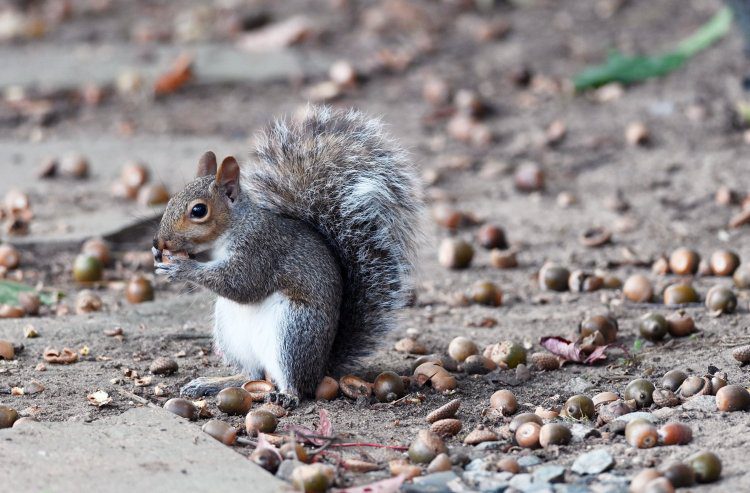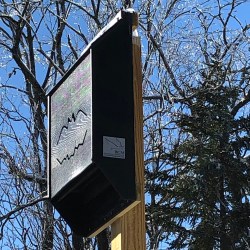

There’s a chance if you see a squirrel gathering acorns on the ground, that same squirrel might have been up in that tree helping those acorns get to the ground. Shawn Patrick Ouellette/Staff Photographer
We always try to answer reader-submitted questions here. Sometimes a question needs a column-length reply, others are quicker to answer. As we head into fall, we’ve received a bunch of questions that I wanted to address briefly, so buckle up for a round of rapid-fire answers.
SQUIRRELS PRUNING TREES
First, a cool observation came in from Maggie Demais of Topsham who noticed gray squirrels biting the ends of limbs off her oak trees. This is a fairly common foraging behavior for squirrels who have an easier time collecting acorns from fallen branches than when they are dangling from high in the tree. We’ve heard from people seeing this before: the squirrels seem to just be pruning, not going after the seeds, but if you count the acorns on the fallen branches one day, then again a day or two later, you’ll typically find they’ve slowly been harvested.
It is worth noting that squirrels will also prune small limbs like this to collect material for their nests and dreys (dreys are a better collective name for the structures they build in trees because they aren’t all used for nesting; some are used more like a pantry or a bedroom, etc.). Anecdotally, while reading up on this, I noticed that more people reported maples being pruned by squirrels in spring and oaks in fall. This makes sense, since as we noted before they are collecting the acorns which are present in the fall, but I’m not sure why they would just favor maples in the spring. Write in if you have a theory about this, or do your own backyard research and see what the squirrels favor in each season.
LACK OF BATS
I never want to ignore any question about bats. This one is from Danielle in Portland who has been noticing the lack of bats all summer and wondering what could be done to help. As you may know, many of our bats have gone through a massive population decline because of a fungal disease, called white-nose syndrome. It causes hibernating bats to stir in the winter and unfortunately die from burning up their fat reserves and not having food (because in winter, there are no insects around for them to eat). We have eight species of bats in Maine, and five of them are in this hibernating or “cave bat” group; the others are migratory and their populations are doing OK.


A bat box should be painted black, which helps retain heat. Maine Audubon photo
There are two key things we can do to help bats, at least on an individual level. First, putting up a bat house to provide them with more habitat will definitely help. That said, unlike birds that will move into a birdhouse within days of putting one up in the spring, bats can take years before they start using a human-made house. I’d recommend visiting the “Living with Wildlife” section on the Maine Department of Inland Fisheries and Wildlife website (mefishwildlife.com) where there is a great section on bats. You can also check out Bat Conservation International (batcon.org) for more information and house-building plans. My quick summary is: bigger is better, and bats (especially this far north) want warmth, so paint them dark and hang them where they’ll get sun. The second thing, though indirect, is reducing or eliminating the amount of pesticides you use. Bats are nature’s pest control and will keep those mosquitoes down, if you let them.
WILDFIRE SMOKE
Through August, you probably noticed the yellow-cast of light or eerie haze of the smoke being blown east from wildfires in the western United States and Canada. This is unfortunately becoming a burgeoning problem and one that we get asked about almost annually. I do want to start with one key fact, coming from a natural history perspective: in some ecosystems, wildfires play an important role in keeping those areas healthy by cycling nutrients back into the soil, which can benefit many plants and animals. However, with increased drought and extreme temperatures from our changing climate, wildfires can become too destructive, for both humans and wildlife.
Deb from Cumberland wrote to us, asking how the smoke will affect our birds. It is hard to know, or appears there isn’t sufficient scientific evidence yet to know what levels of smoke birds can tolerate, at least compared to studies done with human health or even effects on vegetation. Birds have very different respiratory systems than humans, with a much more efficient gas exchange, thus processing more oxygen and pollutants (relative to their size) than humans. This could become an example where we discuss the “canary in the coal mine” as a more literal example.
While I suspect the smoke levels here in Maine are not going to have much or any effect on our birds, I do want to end this article with the plug for the most important things we can do right now to help our local birds. First, keep your cats indoors. We know outdoor cats are the number one anthropogenic cause of mortality in birds with studies showing that over 2 billion birds are killed each year in the U.S. by outdoor cats, and one-third of that is from “owned” cats, not just feral. Domestic cats are a non-native species that we’ve brought here, and it is our responsibility to keep them from annihilating native species, while also keeping the cats safe from native predators.
Second, as we head into the migration season, many birds are at risk of striking windows. Solutions are as simple as shutting lights off at night or treating glass with reflective decals. Keep the questions coming.
Have you got a nature or wildlife question of your own? It doesn’t have to be about birds! Email questions to ask@maineaudubon.org and visit maineaudubon.org to learn more about birding, native plants, and programs and events focusing on Maine wildlife and habitat. Doug and other naturalists lead free bird walks on Thursday mornings, 7 to 9 am, at Maine Audubon’s Gilsland Farm Audubon Sanctuary in Falmouth.
Copy the Story Link
Source link : http://www.bing.com/news/apiclick.aspx?ref=FexRss&aid=&tid=66d44112f96a44e7bc03ffa2016fb4f1&url=https%3A%2F%2Fwww.pressherald.com%2F2024%2F09%2F01%2Fask-maine-audubon-from-squirrels-to-bats-to-wildfire-smokes-impact-on-birds%2F&c=2963481297491739235&mkt=en-us
Author :
Publish date : 2024-08-31 21:01:00
Copyright for syndicated content belongs to the linked Source.